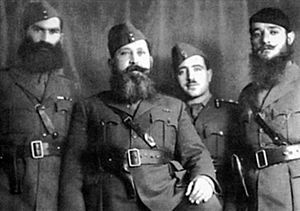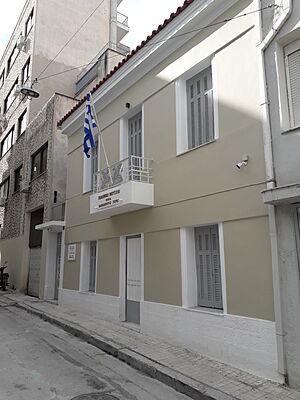Napoleon Zervas facts for kids
Quick facts for kids
General
Napoleon Zervas
|
|
|---|---|

Napoleon Zervas in uniform.
|
|
| Native name |
Ναπολέων Ζέρβας
|
| Born | 17 May 1891 Arta, Kingdom of Greece |
| Died | 10 December 1957 (aged 66) Athens, Kingdom of Greece |
| Buried |
First Cemetery of Athens
|
| Allegiance | |
| Service/ |
|
| Years of service | 1910-1920 1922-1926 1928-1941 1941-1946 (EDES) |
| Rank | General |
| Unit | 2nd Infantry Division |
| Commands held | Leader of EDES |
| Battles/wars | Balkan Wars
Greek Civil War |
| Spouse(s) | Aikaterini Zerva |
| Other work | Member of Party of Liberals (pre-war) Founder of the National Party of Greece (post-war) Twice representative of Ioannina district in the Hellenic Parliament Minister for Public Order Minister of Public Works |
Napoleon Zervas (Greek: Ναπολέων Ζέρβας; May 17, 1891 – December 10, 1957) was a Greek army officer. He became a famous leader during World War II when he fought against the Axis forces occupying Greece. He created and led a group called the National Republican Greek League (EDES). This was one of the most important resistance groups in Greece.
Contents
Early Life and Military Career
Napoleon Zervas was born in Arta, a city in Greece, in 1891. His family came from the village of Souli. In 1910, after finishing school, he joined the army as a volunteer.
Rising Through the Ranks
During the Balkan Wars (1912-1913), Zervas showed bravery and was promoted to first sergeant. He then went to the Hellenic Army NCO School. In 1914, he graduated as a sergeant major.
Zervas supported Eleftherios Venizelos, a famous Greek politician. In 1916, Zervas joined Venizelos's "Movement of National Defense" in Thessaloniki. He fought well in many battles during World War I on the Macedonian front. He was promoted to major.
After Venizelos's party lost the 1920 elections, Zervas left Greece for a short time. He returned in 1922 and rejoined the army.
Political Changes and Challenges
In 1925, when General Theodoros Pangalos became a dictator, Zervas was put in charge of Athens's army. He also led the Second Battalion of the Republican Guard. These troops helped Pangalos stay in power.
However, Zervas later helped overthrow Pangalos in 1926. A month later, Zervas fought against the new leader, General Georgios Kondylis. Zervas's troops fought government forces in Athens. After his defeat, Zervas was sent to prison for life. But in 1928, a new government led by Eleftherios Venizelos gave him a pardon. Zervas was then made a lieutenant colonel in retirement.
Fighting for Freedom: The Resistance Years
Forming EDES
In September 1941, Greece was occupied by Axis powers (Germany, Italy, and Bulgaria). Napoleon Zervas, along with other officers, started the National Republican Greek League (EDES).
The main goals of EDES were:
- To fight against the invaders of Greece.
- To end the Greek monarchy and create a republic.
Zervas strongly disliked both the royal family and communism. At first, EDES did not plan for armed resistance. But after receiving money from British agents, Zervas agreed to lead a guerrilla war in the mountains.
Leading the Guerrillas
In August 1942, Zervas went to the mountains of Epirus. There, he formed the military part of EDES, called EOEA. He used his family connections to recruit fighters. The British military recognized EDES-EOEA as part of the Allied Armies.
Zervas's group included both republicans and royalists. Royalists saw EDES as a good choice compared to EAM, another large resistance group led by Communists. EOEA mostly operated in Epirus, but Zervas also had some control in other areas.
The Gorgopotamos Bridge Attack
In November 1942, EDES forces joined with ELAS (another resistance group) and British and New Zealand experts. They successfully blew up the Gorgopotamos Bridge. This was a very important act of sabotage against the Axis forces. After this success, British agents arrived to train Zervas's fighters and arrange for more weapons.
Changing Sides and British Support
Zervas was a republican, so he was against the king of Greece, who was in exile. However, the British offered more weapons if he supported the king. So, in March 1943, Zervas declared his loyalty to the king. This surprised many of his followers.
The British then sent many more weapons to EDES. In 1943, EDES received twice as many weapons from Britain as EAM did. Even so, British reports suggested that EAM was a larger and more effective resistance group.
In the summer of 1943, all resistance groups worked together in Operation Animals. This was a large campaign of sabotage and attacks against the German army. It was meant to make the Germans think the Allies would invade Greece. As a result, Germany sent eight more divisions to Greece, which helped the Allied invasion of Sicily.
Securing the Ionian Coast
In late 1944, EDES, with British help, took control of the Ionian coast. This led to the expulsion of the Cham Albanian minority from the Greek region of Epirus. Some Chams had worked with the Axis forces. On June 18, 1944, EDES forces attacked Paramythia and freed the town. Many Chams then fled to Albania.
Towards the end of the occupation, EDES was mainly active in Epirus. In December 1944, EDES was attacked by ELAS forces. Zervas and his men had to leave Epirus and go to the island of Corfu. In February 1945, Zervas officially ended his guerrilla force.
After the War
After World War II, Zervas started a new political party called the National Party of Greece. In the 1946 elections, he was elected to the Greek Parliament. His party won 25 seats.
He later served as a minister in the government. From January to August 1947, he was the Minister for Public Order. The United States and the United Kingdom were concerned about his appointment. They thought he might have worked with Nazi Germany during the war or had plans to become a dictator.
As Minister for Public Order, Zervas tried to improve the police force. He also ordered many arrests of Communists. Some believed his actions were creating more problems than they solved.
A few years later, Zervas joined his party with the Liberal Party. He was re-elected to Parliament. He then served as Minister of Public Works from 1950 to 1951. After that, he did not win re-election and left politics.
Napoleon Zervas died in Athens on December 10, 1957.
In 2008, his second wife's house was given to the War Museum Foundation. The plan was to turn it into a museum about his life. The House of General Napoleon Zervas Museum opened in November 2022. It shows exhibits about Zervas's life and the resistance activities of EDES.
Books
- Mazower, Mark. Inside Hitler's Greece: The Experience of Occupation, 1941-44, New Haven, Yale University Press, 1993, ISBN: 0300089236.




